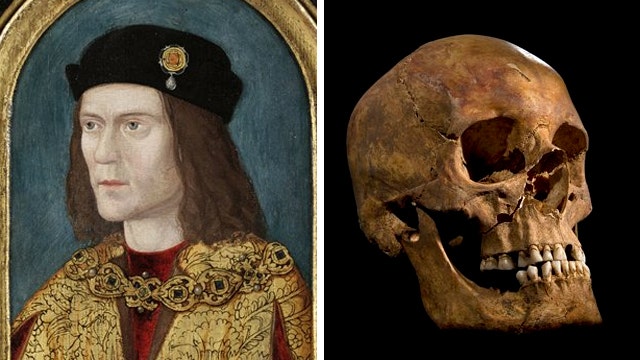DNA confirms identity of King Richard III's remains
Battle-scarred skeleton found under parking lot
LONDON – Scientists say there is "overwhelming evidence" that a skeleton found under a parking lot is that of England's King Richard III, but their DNA testing also has raised questions about the nobility of some of his royal successors.
The bones of the 15th-century king were dug up in the city of Leicester in 2012, and experts have published initial data suggesting they belong to Richard, including an analysis of his curved spine and the injuries that killed him.
Richard was the last English monarch to die on a battlefield, in 1485.
In the new study — probably the oldest forensic case ever solved — scientists compared DNA from the skeleton to living relatives and analyzed DNA data identifying eye and hair color, which they matched to the earliest known portrait of the king.
"Richard can be likened to a missing person's case," said Turi King, a geneticist at the University of Leicester who led the research. "The probability that this is Richard is 99.999 percent," she said. When King and colleagues compared the skeleton's DNA obtained from the ground-up powder of one tooth and a leg bone to samples provided by a 14th cousin on Richard's maternal side, they found a perfect match.
Based on the skeleton's DNA, King and colleagues hypothesized that Richard had blue eyes and blond hair in childhood, which darkened with age. With no contemporary paintings of the king available, they compared their findings to the earliest known painting of him, which depicts the monarch with light brown hair and blue eyes, painted about 25 years after his death.
The research was published Tuesday in the journal, Nature Communications.
Scientists also compared the skeleton's DNA to samples from living relatives on Richard's father's side. They found no match, a discovery that could throw the nobility of some royals into question.
While researchers weren't able to say where on the family tree the adultery occurred, they said the findings potentially raise questions about the legitimacy of Henry V, Henry VI and the entire Tudor dynasty, including Henry VIII and Elizabeth I.
Still, Kevin Schurer, pro vice chancellor of the University of Leicester and another study author, said claims to the throne are based on more than simply having royal blood and also rest on other things such as battlefield victories and royal marriages.
He said England's current royal family — which is related to Richard's sister and to the House of Tudor — should not be worried. "We are not in any way indicating that Her Majesty (Elizabeth II) shouldn't be on the throne," Schurer said.
Researchers said it was the first time there was scientific evidence that questioned medieval lines of succession in the monarchy.
Other academics said history is littered with claims and counter-claims of royal legitimacy.
"When Richard took the throne, he said his brother Edward should never have been king because he was illegitimate," said Steven Gunn, a tutor in history at Oxford University.
Gunn said it was unlikely anyone would ever learn the truth behind the most damaging rumors about Richard — that he murdered his young nephews to hang onto his crown. Still, Gunn said, a more complex picture of the king is now emerging.
"This opens up a new posthumous discussion about Richard's legacy," the historian said. "He has been misrepresented as just a king with scoliosis."





















